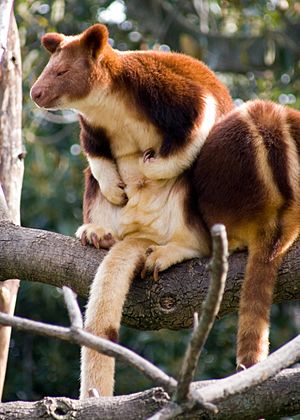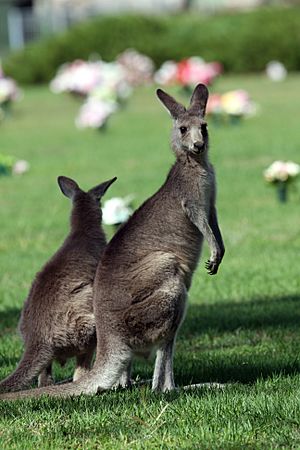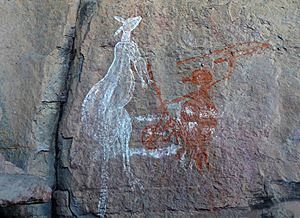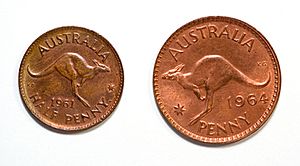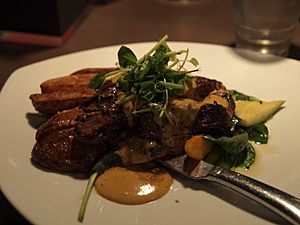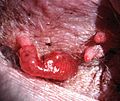Kangaroo facts for kids
Quick facts for kids Kangaroo |
|
|---|---|
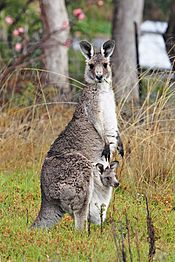 |
|
| Female Eastern Grey Kangaroo with joey | |
| Scientific classification | |
| Kingdom: | |
| Phylum: | |
| Class: | |
| Subclass: | |
| Order: | |
| Suborder: | |
| Family: | |
| Genus: |
in part
|
| Species | |
|
Macropus rufus |
|
A kangaroo is a special type of animal called a marsupial. They belong to the family Macropodidae, which means "large foot." When people say "kangaroo," they usually mean the biggest kinds. These include the red kangaroo, antilopine kangaroo, eastern grey kangaroo, and western grey kangaroo.
Kangaroos live only in Australia. In 2011, the Australian government estimated there were about 34.3 million kangaroos in areas where they are harvested. This was a big jump from 25.1 million just one year before.
The largest animals in this family are called "kangaroos." The smallest ones are usually called "wallabies." Animals of a medium size are known as "wallaroos." There are also tree-kangaroos. These live in the tropical rainforests of New Guinea, far northeastern Queensland, and some nearby islands.
The kangaroo is a national symbol of Australia. You can see it on the Australian coat of arms and on some of its money. Many famous Australian groups, like Qantas (an airline) and the Royal Australian Air Force, use the kangaroo as their symbol. Kangaroos are very important to Australian culture and its image around the world.
Contents
What Does "Kangaroo" Mean?
The word "kangaroo" comes from the Guugu Yimithirr word gangurru. This word refers to the grey kangaroos. The name was first written down as "kanguru" on July 12, 1770. This was in the diary of Sir Joseph Banks.
This happened near what is now Cooktown. HMS Endeavour, led by Lieutenant James Cook, was there for almost seven weeks. They were repairing damage from the Great Barrier Reef. Cook first wrote about kangaroos in his diary on August 4. Guugu Yimithirr is the language of the people who lived in that area.
Early European explorers thought kangaroos were very strange animals. They said kangaroos had heads like deer but no antlers. They stood up like people and hopped like frogs. Some people back home thought these stories were made up. This was especially true when they heard about mother kangaroos with two "heads" (the joey in the pouch).
The first kangaroo seen in the Western world was shot by John Gore. He was an officer on Captain Cook's Endeavour in 1770. The animal's skin and skull were sent to England. Taxidermists who had never seen a kangaroo before stuffed it. It was then shown to the public as a curiosity. Many people in the 1700s first saw a kangaroo in a painting by George Stubbs.
Kangaroos are often called "roos" for short. Male kangaroos are called bucks, boomers, jacks, or old men. Females are called does, flyers, or jills. Baby kangaroos are called joeys. A group of kangaroos is called a mob, troop, or court.
Kangaroo Life and Habits
Kangaroos are herbivores, meaning they eat only plants. They mostly eat grass, but some kinds also eat shrubs. Because they graze so much, kangaroos have special teeth. These teeth are rare among other mammals.
Kangaroos are the only large animals that hop to move around. They can jump about three times their own height. A red kangaroo usually hops at about 20–25 kilometers per hour (kph). But they can reach speeds of up to 70 kph over short distances. They can keep a speed of 40 kph for almost 2 kilometers.
This fast and energy-saving way of moving helps them travel long distances. They need to find food and water regularly. It's not just for escaping predators. When moving slowly, a kangaroo uses its strong tail like a third leg. It forms a tripod with its front legs while moving its back feet forward. Kangaroos are also good swimmers. They often jump into water if they feel threatened.
Kangaroos are marsupials because they carry their young in a special pouch. Baby kangaroos are called joeys. Kangaroos can be dangerous because of their very powerful legs. They can lean back on their tails and deliver strong kicks.
Kinds of Kangaroos
There are four main types of kangaroos alive today:
- The Red Kangaroo (Macropus rufus) is the biggest marsupial in the world. It lives in the dry and semi-dry central parts of Australia. A large male can be 2 meters (6 feet 7 inches) tall and weigh 90 kilograms (200 pounds).
- The Eastern Grey Kangaroo (Macropus giganteus) is not as famous as the red kangaroo outside Australia. But it is the most commonly seen. It lives in the fertile eastern part of the continent.
- The Western Grey Kangaroo (Macropus fuliginosus) is a bit smaller. A large male weighs about 54 kilograms (119 pounds). It lives in southern Western Australia, coastal South Australia, and the Darling River basin.
- The Antilopine Kangaroo (Macropus antilopinus) looks similar to the Eastern and Western Greys. Like them, it lives on grassy plains and in woodlands. They often live in large groups.
There are also about 50 other smaller macropods in the macropodidae family.
How Kangaroos Are Born and Grow
Kangaroos have special ways of living in dry, less fertile lands with changing weather. Their babies are born very early. After only 31–36 days, a joey is born. At this stage, only its front legs are developed enough. This lets the tiny newborn climb into the pouch and attach to a teat. When a joey is born, it is about the size of a lima bean.
The joey usually stays in the pouch for about 9 months. For Western Greys, it can be 180–320 days. After this, it starts to leave the pouch for short times. The mother usually feeds her joey until it is about 18 months old.
Kangaroos have large, stretchy tendons in their back legs. These tendons store energy like springs. This spring action provides most of the power for each hop. It means their muscles don't have to work as hard. This is true for many animals, but it's very clear in kangaroos.
There's also a link between hopping and breathing. As their feet leave the ground, air is pushed out of their lungs. When they bring their feet forward to land, their lungs refill. This makes them even more energy efficient. Studies show that once a kangaroo starts hopping, going faster takes very little extra effort. This is much less effort than for a horse, dog, or human running at the same speed.
The main benefit of hopping for kangaroos is not just speed to escape predators. Their top speed is similar to other animals their size. Instead, it's about saving energy. In Australia's dry lands with changing weather, kangaroos need to travel far to find food. Being able to travel long distances efficiently is key to their survival.
New research shows that a kangaroo's tail acts like a third leg. It's not just for balance. Kangaroos have a special three-step walk. They first put down their front legs and tail. Then they push off their tail. Finally, they bring their back legs forward. The tail's pushing power is as strong as both the front and back legs combined. It does as much work as a human leg walking at the same speed.
What Kangaroos Eat
Kangaroos have stomachs with only one chamber. This is different from cows and sheep, which have four. Sometimes, they bring up the plants they've eaten and chew them again, like cud. Then they swallow it again for final digestion. However, this is harder for kangaroos and happens less often than in animals like cows.
Different kinds of kangaroos eat different things. But all of them are strict herbivores (plant-eaters). The eastern grey kangaroo mainly eats grass. Other types, like the red kangaroo, eat a lot of shrubs too. Smaller kangaroos also eat fungi that grow underground. Many kangaroos are nocturnal (active at night) or crepuscular (active at dawn and dusk). They usually rest in the shade during hot days. They move around and feed during the cool evenings, nights, and mornings.
Who Hunts Kangaroos?
Kangaroos have some natural predators. The thylacine, a type of wolf-like marsupial, used to hunt kangaroos. But it is now extinct. Other extinct predators included the marsupial lion, Megalania (a giant lizard), and Wonambi (a giant snake). When humans arrived in Australia about 50,000 years ago, and dingoes about 5,000 years ago, kangaroos had to learn to adapt.
Today, besides dingoes, other animals brought to Australia also threaten kangaroos. These include foxes, feral cats, and both pet and wild dogs. As mentioned before, kangaroos are good swimmers. They often escape into water if a predator threatens them.
Extinct Giant Kangaroos
There was once a family of giant kangaroos called Sthenurinae. They are now extinct. These giant kangaroos were made for eating plants in woodland areas, not open grasslands. The biggest one, Procoptodon goliah, weighed about 240 kilograms. This is almost three times the weight of the largest kangaroos alive today.
They probably moved slower than modern kangaroos. Hopping was not possible for them. Instead, they would have moved by striding or walking. This family of giant kangaroos died out about 30,000 years ago.
Kangaroos and People
The kangaroo has always been very important to Australian Aborigines. They used kangaroos for meat, hide, bone, and tendon. Kangaroos also play a big part in their Dreaming stories and ceremonies. Aherrenge is a special kangaroo dreaming site in the Northern Territory.
Unlike many smaller marsupials, kangaroos have done well since Europeans settled in Australia. European settlers cut down forests to create large grasslands for sheep and cattle. They also added water sources in dry areas. And they greatly reduced the number of dingoes.
Kangaroos are usually shy and avoid people. They normally do not pose a threat to humans. In 2003, a hand-raised eastern grey kangaroo named Lulu saved a farmer's life. She alerted his family when he was hurt by a falling tree branch. Lulu received the RSPCA Australia National Animal Valour Award in 2004. There are very few reports of kangaroos attacking humans without being provoked.
Kangaroos in Culture
The kangaroo is a well-known symbol of Australia. The kangaroo and the emu are on the Australian Coat of Arms. Kangaroos have also been on coins, especially the five kangaroos on the Australian one dollar coin. The Australian Made logo has a golden kangaroo in a green triangle. This shows that a product is grown or made in Australia. Kangaroos and wallabies are often used in the names and mascots of Australian sports teams.
Kangaroos appear a lot in films, television, books, toys, and souvenirs. They are even in some Christmas carols. Skippy the Bush Kangaroo was the star of a popular Australian children's TV show in the 1960s.
Kangaroo Meat
Historically, kangaroo meat was a main food source for indigenous Australians. Kangaroo meat is high in protein and low in fat (about 2%). It is also a good source of vitamins and minerals.
Most kangaroo meat today comes from wild animals. It is a byproduct of programs that manage kangaroo populations. Licensed hunters harvest kangaroos following strict rules. Kangaroos are protected by state and federal laws. Kangaroo meat is exported to many countries around the world.
Images for kids
-
A male red kangaroo
-
A male red kangaroo grazing
-
The skull of an extinct giant kangaroo, Sthenurus.
-
Aboriginal Australians hunting kangaroos.
See also
 In Spanish: Canguro para niños
In Spanish: Canguro para niños




